Ghosts of Berlin
Ghosts of Berlin is a project by Gabrielle Nankivell with the artistic collaboration of Laurie Young and Raul Maia. This project is generously supported by the Tanja Liedtke Foundation through the Tanja Liedtke Fellowship and hosted by aDaStudio, Berlin.
A Proposition for Berlin
When is a body just a body?
When is a body channeling the experience of the surrounding environment?
How is a body the carrier of history?
How are these threads of immediacy or history used to generate something that responds, but at the same time becomes?
Can we combine these?
For this project I am considering two types of documentation. These documents contain the history of a defined place and period of time.
Berlin.
3 weeks.
The first considers my body as a document, where the experience of doing resides in my memory and my flesh. The second uses the analogue and digital recording mediums available to me to create visual documentation from the perspective of a photographic 'eye'.
Documenting history is a particular way of framing. The chronological development of my personal history includes a non-linear accumulation of information. It is formed in a cycling, mutating, infecting manner that constantly moves in on itself and rewrites history. To counter the swirling mass of information in the body, the analogue/digital documentation will follow an arranged, formal approach.
The individual frames within the documentation media include:
Postcards
Letters written on the reverse of the postcards
Two performing bodies
The eyes of one performer
An analogue stills camera as the eye of the other performer
A digital GoPro
A Polaroid camera with instant film
The documentation to be produced includes:
Postcards
Letters written on the reverse of the postcards
Voice recordings of these letters
Film (negatives)
Contact sheets
Developed prints
Digital video files
Instant prints
The experience ingrained in the bodies of the performers
Physicality (via muscle, sensorial & experiential memory) replicated out of context (in the studio)
Written reflections
Input from random observers on site (comments, photos, videos, questions)
Anticipating documentation outcomes…
From the perspective of this project history is about time. The temporal reality in which the images and video are recorded won't necessarily match the things we see in the resulting documentation materials. For example, a series of developed prints may look as if they were created using rapid-fire photography when in reality there might be 40 seconds or more between each shot. The speed with which the performers complete a score during the recording phase will influence the outcome. In this sense both the period of data collection and the documentation outcomes offer space for us to manipulate and bend time. We can organise history to suit our own agenda, moving from content to form through the exploration of medium. The act of formation could create its own narrative.
Laurie lives in Berlin. Raul does not. I have visited a number of times for varying durations and am trying to establish my relationship with the history of the city. The history captured within the buildings, spaces and people of the city as well as my own personal history of having inhabited this location at other points in time.
Laurie is the architect, she designs little field trips for Raul and I based on her perception of the city and the specific ways she might orchestrate our experience. Our adventures begin with an SMS; a meeting point and public transport instructions for how to get there. On arrival we receive a pre-written postcard, this gives us a visual frame and offers content with which to perform our score.
Raul is the conservator, or perhaps the creative anthropologist. He works with me to define and implement our scores and translate them on location. His manual, analogue photographic capture of each score combines a sense of past and present and situates the human aspect within the landscape.
I am the evolving historian. I use the tools of the architect and conservator to perform the field trip and gather data. I document my experience with words, images and movements to create new artefacts. These artefacts are sewn into my studio practice.
Towards a documentary style performance these artefacts are considered small pieces of both my personal history and a broader collective history of the city.
We are all documentarians.
ALEXANDERPLATZ
Original movement score & GoPro footage duration: 10 minutes
Number of B&W photographs: 36
Number of Polaroid: 3
Notes: Birds, lines of sight and a giant disco ball in the sky.
When I'm lost I look for 'Alex'.
BERNAUER STRASSE
Original movement score & GoPro footage duration: 10 minutes
Number of B&W photographs: 36
Number of Polaroids: 3
Notes: The less I do, the more obvious I become.
I notice a taxi van approaching in the distance.
She lies motionless, maybe 25 – 30 seconds.
BRANDENBURGER TOR
Original movement score & GoPro footage duration: 16 minutes
Number of B&W photographs: 36
Number of Polaroids: 3
Notes: Performing our score at Brandenburger Tor during peak tourist season with a ranting soapbox demonstration that touched on subjects as wide-ranging as the anniversary of the Hiroshima bombing and vapor trail conspiracy theories as our backdrop, was quite an experience. Add to that some territorial street performers, a tarot reader and a small pack of go-carts and things became decidedly surreal. Embracing capitalism and an ice-cold café latte frappe monstrosity at Starbucks brought us much more than just shade and sugar… Two wonderful strangers instigated an insightful conversation around what they described as the 'Brandenburg Gate Photo Dance'. They even followed up by emailing us a video they made of our experiment. Serendipity in full effect!
Meanwhile talk about foreign policy – “America, Canada, Germany”. “Fracking” – Gab happens to make a gesture – arm and hand outstretched toward the ground. The guy is talking about drilling for oil as she does this.
DENKMAL FÜR DIE ERMORDETEN JUDEN EUROPAS
Original movement score & GoPro footage duration: 31 minutes
Number of B&W photographs: 36
Number of Polaroids: 4
Notes: Two security guards and a nun.
A kid – about 15 yrs. Old (“undercut boy”) asks a woman to take a photo of him. He poses big time.
They disappear for a long time. I'm left alone. People seem to appear out of nowhere. They disappear again. They walk into view. Raul and Gab are face to face. She is smiling and talking to him. I'm not sure what's going on. Gab walks away toward the street – I notice the security guards checking it out. There are two of them.
TACHELES
Original movement score & GoPro footage duration: unknown + 2 minutes
Number of B&W photographs: 36
Number of Polaroids: 5
Notes: Tacheles is no longer. The derelict site is under private ownership and the point of view from which the postcard photograph was taken is no longer accessible to the public. Raul, our ever-resourceful adventurer, sweet-talked his way into the offices of an Internet company whose building adjoins the site. One of their web developers kindly guided us through the building to a window overlooking Tacheles, the closest viewpoint to our elusive postcard picture. Here he supervised Raul's documentation of the view. Technically no cameras are allowed inside the offices so no GoPro footage was recorded. The score was continued using all frames when we returned outside.
So yeah we have 30. So don't go too fast otherwise…
Ok.
Which is the classic for stop motion animation classic mistake.
Gab goes too fast. Oh, Gab always goes to fast. I don't know, she's like… speed machine. Although I have a feeling Laurie can go faster than I can. I hear this on good authority.
TUCHOLSKY STRASSE
Original movement score & GoPro footage duration: 9 minutes
Number of B&W photographs: 36
Number of Polaroids: 3
Notes: I write about Laurie. Her recollections are my ghosts.
It's not a performative plan; it's a photo plan.
HAUS SCHWARTZENBERG
Original movement score & GoPro footage duration: 1.5 minutes
Number of B&W photographs: 36
Number of Polaroids: 5
Notes: Sometimes the annoying ones are diamonds in retrospect.
Her eyes close - it looks effortful – not a simple blink – she squeezes her eyes closed. Some tourists stop to watch. Not wanting to disturb the shoot. One took a photo with his phone.
The documentarian - Studio Work
I stood completely still, my clothes and body motionless from lack of depth in breath. Somehow I really thought I would be invisible. This was the first time I had tried something like this and all my assumptions about what it would be like fell flat.
The postcard had led me to Bernauer Strasse, a broad expanse of empty space where the Berlin Wall once stood. The photograph on the front was taken in 1985, four years before the wall would fall. Men and women queued in the snow beside a cobbled road. They were waiting their turn at a wooden platform with a view over the wall.
I found my place beside the watchtower. I was at the border, or at least in the presence of an absent border. Immediately I thought of other borders I had met in the preceding weeks, Palestine and Israel, Greece and Europe and Australia and the open sea.
Bordering experience. This term had come up a lot at a symposium I attended last week, along with questions around the agency of the body in this environment. Traversing a border can involve varying amounts of hesitation, desperation, desire, resistance and routine. A passive stance is required but the bordering body is inevitably and invisibly pulled in opposite directions. In one direction anxiety, impatience and even fear arise. In the other the body must breathe, be still and stay calm. Anything other than this calls attention to itself.
It occurs to me that the reality of control, manipulation and denial so present in the experience of many border crossings counters my other concrete notion of traversing borders, that of cultural exchange and artistic mobility. As bordering experiences these instances share some qualitative content but that is where the comparisons cease. Borders are a spatial entity and a hard-line mechanism of power. Borders are also transient. They are constantly being negotiated via politics, economy and culture as territories are modified and realities redefined. Within the frame of cultural exchange I stand at a now absent border. The weight of bordering experiences past hangs in the void of this historical site.
I found my place beside the watchtower. I was at the border, or at least in the presence of an absent border. I felt the obviousness of my usually inconspicuous outfit – black dress; black shirt; black runners; dark sunglasses – an outfit made for blending in, unless of course you are standing motionless at a major tourist site in the direct path of desperate pedestrian traffic. People walk, talk, look around, pose and take photos - anything other than this calls attention to itself.
I am amidst the crawling ant nest of a tourist hot spot at peak-hour in mid-summer. I am at the border, or absence of a border standing impossibly still. I avoid eye contact but take in the scene. My view bounces between fat tourists with too much luggage and a slew of people with physical disabilities and mobility aids. Bright coloured thin stretch fabrics cling to the cascading rolls and bulges of waddling visitors. Sweat glistens on upper lips and elbow creases under the strain of 30-kilo-plus cases and the 4pm sun. Like a hot, wide, march of emperor penguins they stagger toward the Dokumentationszentrum.
Some of the penguins eye me off suspiciously, craning their thick necks as they pass too close to my still, silent body. With eyes glazed over, others graze past as if I am not even there. I believe in my stillness so perhaps they really don’t see me. If this is true I might also keep the security guards from sensing my presence. A sweating, older man with a white moustache barks at me in German.
‘What are you doing, what is this?’
Zero response.
Nothing.
Not even on a cellular level.
He is becoming agitated.
I am making him agitated.
He moves to shove my shoulder.
I move before he connects.
I walk.
My heart is racing but I feel the air immediately drying the sweat on my face. The standing man of Taksim Square must have had it much worse. If you stand only for a little while all you receive is apprehension and aggression. Stand some more and people join you. You become an icon. Or, you risk becoming an icon.
As soon as I walk people forget my presence, I meld with the mass. My feet find the line of where the wall was. I lie face down. My body stretches its entire length along the line. I become the border. The cobbles are hot against my cheek but the stares of people queued at the traffic light cut across the crossing and set my body alight. As my anxiety rises, I inhale to stay calm. As the anxiety of the people watching rises, they exhale to stay calm. The scene holds its breath.
Before the time that passes is too little or too long, I stand. I walk.
Almost as soon as I walk people forget my presence.
My body holds the agency of my experience. Those who approached, receded or held their breath remember the agency of my body. Perhaps I held the absence of history with my presence, or perhaps history held the presence of its absence with my breath.
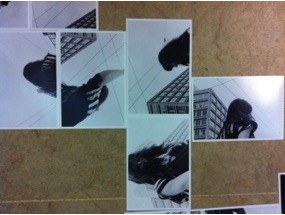

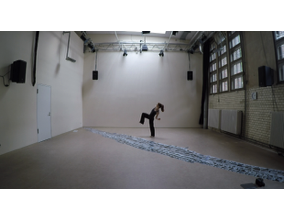
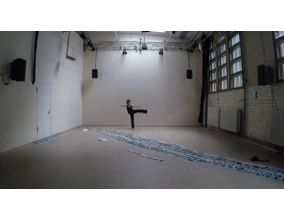
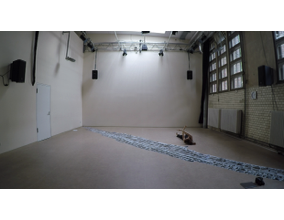

Many Documentarians – Performance Work
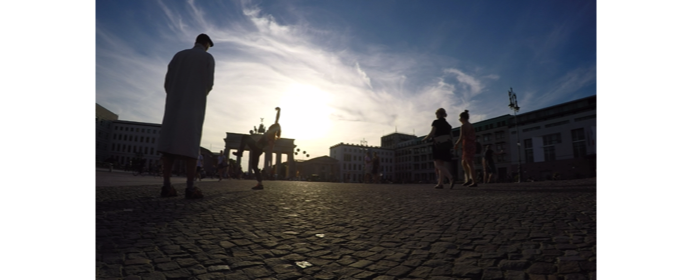
Field Trips
Performing Scores & Developing Documents
Photos: Raul Maia & Gabrielle Nankivell
All contents of this wesite are © Gabrielle Nankivell 2021
Gabrielle Nankivell